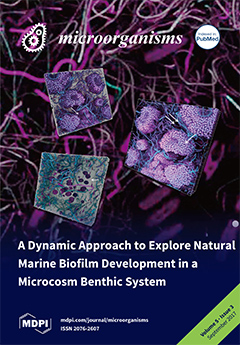Microorganisms are able to form biofilms within respiratory secretions. Methods to disaggregate such biofilms before utilizing standard, rapid, or high throughput diagnostic technologies may aid in pathogen detection during ventilator associated pneumonia (VAP) diagnosis. Our aim was to determine if sonication of endotracheal
[...] Read more.
Microorganisms are able to form biofilms within respiratory secretions. Methods to disaggregate such biofilms before utilizing standard, rapid, or high throughput diagnostic technologies may aid in pathogen detection during ventilator associated pneumonia (VAP) diagnosis. Our aim was to determine if sonication of endotracheal aspirates (ETA) would increase the sensitivity of qualitative, semi-quantitative, and quantitative bacterial cultures in an animal model of pneumonia caused by
Pseudomonas aeruginosa or by methicillin resistant
Staphylococcus aureus (MRSA). Material and methods:
P. aeruginosa or MRSA was instilled into the lungs or the oropharynx of pigs in order to induce severe VAP. Time point assessments for qualitative and quantitative bacterial cultures of ETA and bronchoalveolar lavage (BAL) samples were performed at 24, 48, and 72 h after bacterial instillation. In addition, at 72 h (autopsy), lung tissue was harvested to perform quantitative bacterial cultures. Each ETA sample was microbiologically processed with and without applying sonication for 5 min at 40 KHz before bacterial cultures. Sensitivity and specificity were determined using BAL as a gold-standard. Correlation with BAL and lung bacterial burden was also determined before and after sonication. Assessment of biofilm clusters and planktonic bacteria was performed through both optical microscopy utilizing Gram staining and Confocal Laser Scanning Microscopy utilizing the LIVE/DEAD
®BacLight kit. Results: 33 pigs were included, 27 and 6 from
P. aeruginosa and MRSA pneumonia models, respectively. Overall, we obtained 85 ETA, 69 (81.2%) from
P. aeruginosa and 16 (18.8%) from MRSA challenged pigs. Qualitative cultures did not significantly change after sonication, whereas quantitative ETA cultures did significantly increase bacterial counting. Indeed, sonication consistently increased bacterial burden in ETAs at 24, 48, and 72 h after bacterial challenge. Sonication also improved sensitivity of ETA quantitative cultures and maintained specificity at levels previously reported and accepted for VAP diagnosis. Conclusion: The use of sonication in ETA respiratory samples needs to be clinically validated since sonication could potentially improve pathogen detection before standard, rapid, or high throughput diagnostic methods used in routine microbial diagnostics.
Full article






